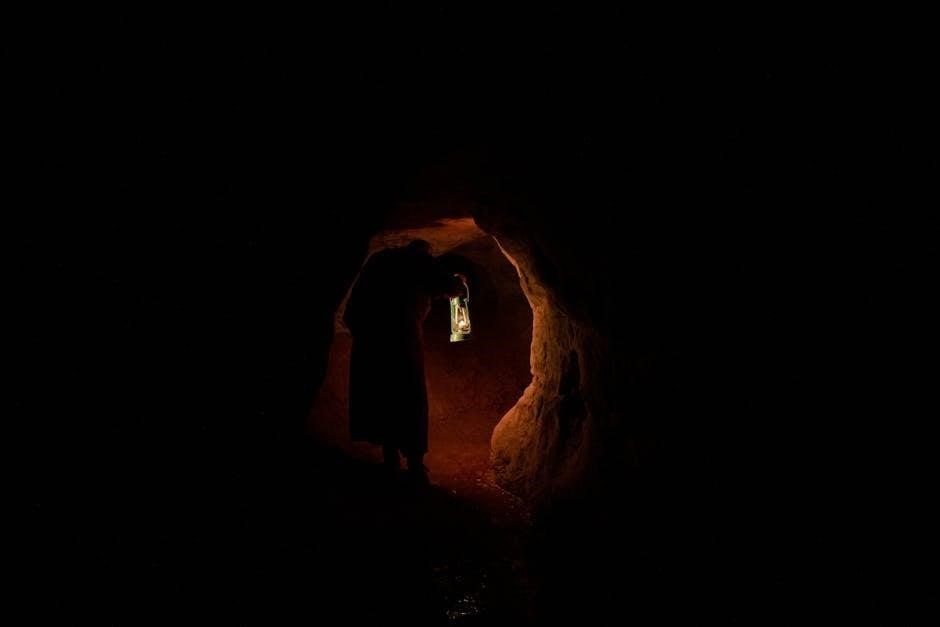Waterworks are systems designed to collect, treat, and distribute water, ensuring a safe and reliable supply. They play a crucial role in addressing water scarcity and promoting sustainability, as highlighted in global reports and initiatives like Peru’s water governance efforts, which are essential for public health and environmental protection.
1.1 Definition and Purpose of Waterworks
Waterworks refer to systems and infrastructure designed to collect, treat, and distribute water for human consumption, industrial use, and environmental needs. Their primary purpose is to ensure a safe and reliable water supply, addressing water scarcity and promoting public health. Waterworks play a critical role in transforming raw water into drinkable form, making it accessible to communities while adhering to quality standards. They also support economic activities and environmental sustainability, as highlighted in global initiatives like the United Nations World Water Development Report, emphasizing collective responsibility for water management. Efficient waterworks are essential for preventing waterborne diseases and ensuring equitable access to this vital resource.
1.2 Historical Development of Water Supply Systems
The development of water supply systems dates back to ancient civilizations, where early humans recognized the need for clean water. The Romans pioneered aqueducts, while ancient Egyptians developed canals for irrigation. In the Middle Ages, wells and cisterns were primary sources, but urbanization demanded more complex systems. The Renaissance brought advancements in engineering, leading to pumps and distribution networks. The Industrial Revolution introduced municipal waterworks, incorporating filtration and treatment. Modern systems now integrate advanced technologies, ensuring safer and more efficient water delivery. Historical innovations have laid the foundation for today’s sophisticated waterworks, emphasizing the importance of continuous improvement in water supply systems.

Water Treatment Process
The water treatment process transforms raw water into safe drinking water through screening, filtration, and disinfection, ensuring the removal of contaminants and harmful pathogens effectively.
2.1 Sources of Raw Water
Raw water sources include rivers, lakes, reservoirs, groundwater, and seawater. These sources vary in quality and availability, necessitating tailored treatment approaches. Rivers provide consistent flow, while lakes offer storage benefits. Groundwater is often cleaner but requires extraction. Reservoirs store water for dry seasons, ensuring supply stability. Seawater is used in coastal areas but demands desalination. Each source has unique challenges, like seasonal fluctuations or contamination risks, influencing treatment processes. Understanding these sources is crucial for effective water management and ensuring sustainable supply systems.
2.2 Steps in Water Treatment
The water treatment process involves several critical steps to ensure water safety. First, coagulation and sedimentation remove particulate matter by adding chemicals that clump impurities, which then settle out. Next, filtration passes water through layers of sand and gravel to capture remaining particles. Disinfection follows, using UV light, chlorine, or ozone to eliminate pathogens. Additional treatments may include aeration to remove odors or dissolved gases, and remineralization to adjust pH levels. Finally, the treated water is stored and distributed to consumers. Each step is essential to produce clean, safe drinking water, addressing specific contaminants and enhancing water quality effectively for public health protection.
2.3 Role of Chemicals and Filtration in Water Purification
Chemicals play a vital role in water purification by removing impurities and contaminants. Coagulants like alum are used to clump suspended particles, making them easier to remove. Disinfectants, such as chlorine or ozone, eliminate bacteria and viruses, ensuring water is safe for consumption. Filtration further enhances purity by passing water through porous materials like sand or membranes, capturing remaining particles. Together, these processes effectively reduce turbidity, pathogens, and harmful substances, producing high-quality drinking water. The combination of chemical treatment and physical filtration ensures comprehensive purification, addressing a wide range of waterborne contaminants and safeguarding public health.

Water Distribution Systems
Water distribution systems deliver treated water from treatment plants to consumers through a network of pipes, pumps, and valves. These systems ensure reliable and efficient water supply.
3.1 Infrastructure Components (Pipes, Pumps, Valves)
Water distribution systems rely on a network of infrastructure components, including pipes, pumps, and valves. Pipes, made of materials like PVC, metal, or concrete, transport water across long distances. Pumps are essential for creating the pressure needed to move water through the system, especially in areas with elevation changes. Valves control the flow of water, enabling shutdowns for maintenance or emergencies. Together, these components ensure efficient and reliable water delivery to households, businesses, and institutions. Their design and maintenance are critical to preventing leaks, contamination, and service interruptions, making them the backbone of modern water distribution systems.
3.2 Water Storage Solutions (Reservoirs, Tanks)
Water storage solutions, such as reservoirs and tanks, are critical for ensuring a steady water supply. Reservoirs, often large and naturally occurring or artificial, store raw or treated water, while tanks are smaller, elevated structures that maintain water pressure in distribution systems. These storage solutions help balance supply and demand, especially during peak usage or emergencies. Made from materials like concrete, steel, or reinforced plastics, they are designed for durability and safety. Regular maintenance, including cleaning and inspections, is essential to prevent contamination and ensure reliability. Effective storage systems are vital for sustaining water availability and quality in communities worldwide.
3.3 Maintenance and Repair Practices
Regular maintenance and timely repairs are essential for the longevity and efficiency of water distribution systems. This includes inspecting pipes for leaks, cleaning storage tanks, and replacing worn-out components like valves and pumps. Corrosion control measures, such as applying phosphate-based inhibitors, are critical to prevent infrastructure degradation. Maintenance also involves monitoring water quality parameters to ensure safety standards are met. Scheduled repairs and proactive approaches help avoid unexpected failures, minimizing disruptions to water supply. Effective maintenance practices not only protect public health but also reduce operational costs and extend the lifespan of waterworks infrastructure, ensuring reliable service delivery to communities.

Water Quality Assurance
Water quality assurance involves testing and monitoring to ensure water meets safety standards, protecting public health and environmental integrity through consistent regulation and reliable data collection practices.
4.1 Key Parameters for Water Quality Testing
Key parameters for water quality testing include pH levels, temperature, dissolved oxygen, turbidity, and the presence of harmful bacteria. Additionally, chemical contaminants such as lead, arsenic, and nitrates are monitored to ensure compliance with safety standards. Regular testing also assesses nutrient levels, like phosphates, which can impact water clarity and environmental health. These parameters help determine if water is safe for drinking, recreational use, or industrial applications, ensuring public health and ecosystem protection. By maintaining strict testing protocols, waterworks systems can prevent contamination and uphold regulatory requirements, safeguarding communities and natural resources effectively.
4.2 Regulatory Standards for Drinking Water
Regulatory standards for drinking water are established to ensure water safety and protect public health. Key parameters include acceptable levels of pH, bacteria, viruses, and chemical contaminants like lead and arsenic. These standards are enforced by regulatory bodies such as the WHO and EPA. Regular testing and compliance are mandatory to prevent health risks. The standards also address disinfection byproducts and nutrient levels to maintain water quality. By adhering to these regulations, waterworks systems ensure the delivery of safe drinking water, safeguarding communities and reducing the risk of waterborne diseases. Compliance with these standards is critical for maintaining public trust and environmental sustainability.
4.3 Public Health Implications of Safe Water Supply
Safe water supply is critical for preventing waterborne diseases like cholera and dysentery, reducing child mortality rates, and promoting overall community health. Access to clean water minimizes the risk of infections, ensuring healthier populations and lowering healthcare costs. It also supports proper hygiene practices, reducing the spread of illnesses. Safe water supply prevents outbreaks, protecting vulnerable groups such as children, the elderly, and immunocompromised individuals. Improved water quality enhances nutritional intake and energy levels, fostering productivity and economic stability. Addressing waterborne risks through reliable systems ensures long-term public health benefits, making safe water a cornerstone of sustainable development and societal well-being, particularly in underserved and underprivileged populations.

Future of Waterworks
The future of waterworks lies in innovative technologies, sustainable practices, and smart systems to ensure efficient water management, conservation, and reuse, addressing global water challenges effectively.
5.1 Innovations in Water Treatment Technologies
Advancements in water treatment technologies are transforming the industry, with innovations like AI-driven monitoring systems, advanced membrane filtration, and UV disinfection improving efficiency and safety. These innovations enhance water quality, reduce energy consumption, and promote sustainability. For instance, smart sensors now monitor water parameters in real-time, enabling predictive maintenance and minimizing contamination risks. Additionally, the use of renewable energy sources in treatment plants is gaining traction, further aligning waterworks with global sustainability goals. Such cutting-edge solutions are critical for addressing future water challenges and ensuring clean, accessible water for all.
5.2 Sustainability and Water Conservation Strategies
Sustainability and water conservation are vital for ensuring long-term water availability. Strategies include water recycling, rainwater harvesting, and efficient irrigation systems. Smart technologies, such as smart meters and leak detection systems, help monitor and reduce water waste. Promoting water-saving habits through education and public awareness campaigns further enhances conservation efforts. Additionally, integrating renewable energy sources into water treatment processes reduces operational costs and environmental impact. These strategies not only protect natural resources but also build resilience against climate change and population growth, ensuring a sustainable future for waterworks systems worldwide.





















